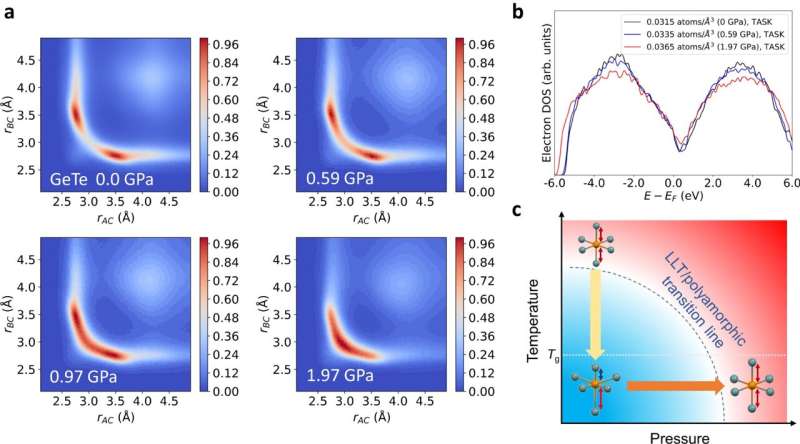This article has been reviewed according to Science X's editorial process and policies. Editors have highlighted the following attributes while ensuring the content's credibility:
fact-checked
peer-reviewed publication
trusted source
proofread
A mechanism of pressure-induced glass phase transition leading to advanced phase-change memories

When temperature or pressure is applied to a material, its state changes from liquid to solid or remains solid but exhibits structural changes. This change is called a phase transition or change.
Glass is an uncrystallized solid. When a liquid is rapidly cooled, it becomes a supercooled liquid by avoiding crystallization beyond its freezing point and transitions to a hard glassy state upon further cooling.
The atomic arrangement inside the glass is apparently disordered; however, the arrangement exhibits various regularities that are closely related to the physical and chemical properties of glass. Additionally, glass properties are crucial in phase-change materials used as recording films for fabricating nonvolatile memory and optical disks, such as Blu-ray disks, wherein glass properties are critical to device performance.
These materials exhibit considerable changes in their glass properties (phase transition) with variations in temperature and pressure; however, the underlying atomic arrangement changes have not yet been elucidated.
A research group led by the University of Tsukuba combined high-pressure diffraction experiments using high-brilliance synchrotron radiation X-rays with numerical simulations utilizing machine learning to investigate changes in the atomic arrangement of phase-change materials (glasses) as a function of pressure. The paper is published in the journal Nature Communications.
Researchers have found that the regular atom arrangement, called "Peierls-like distortion," observed under atmospheric pressure is suppressed with increasing pressure. Furthermore, they found that the volumetric modulus of glass elasticity increases accordingly (i.e., the volume of glass does not change easily under pressure).
The mechanism underlying such a phase transition in glass is essentially the same as that observed in a supercooled liquid. The behavior of phase-change materials when acting as supercooled liquids plays an important role in the writing speed and data retention of optical disks.
These results demonstrate that the Peierls-like strain is an essential structural feature that determines the characteristics of phase-change materials. These results may provide a foundation for the development of new materials for advanced phase-change memory and other applications.
More information: Tomoki Fujita et al, Pressure-induced reversal of Peierls-like distortions elicits the polyamorphic transition in GeTe and GeSe, Nature Communications (2023). DOI: 10.1038/s41467-023-43457-y
Journal information: Nature Communications
Provided by University of Tsukuba





















